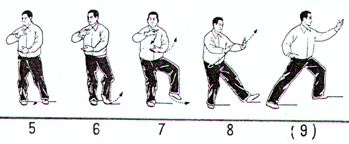Taijiquan Movement #5: Part Wild Horse Mane

Weekend is finally here and I can finally get to writing this weekend's post! :)
Today's Taijiquan move is also found in almost all forms being taught in the world today. Readers who practice Tai Chi, but who have never bothered to find out about any of its combat applications might find the applications of this move interesting.
If you are a Karate student you are most likely, just like me, used to techniques having simple names. Gyaku Zuki, Mawashi Geri and so forth. The trouble with the names of Kungfu movements, especially Taijiquan's, is that the absence of a visual demonstration would leave the uninitiated at a loss for any idea what the move's function is or even how it is performed.
Fortunately- I have found photos and videos to give non- Tai chi folk an idea of how this movement is performed and what use it has in a fight.
In Shotokan Karate's kata Enpi we have a similar move that looks like this:
The two claw-hands look really menacing and makes the movement look a lot scarier than its Taijiquan counterpart.
What is agreed by most exponents of Taijiquan is that the body rotation at the start is very important as it is used to evade a frontal attack from your opponent.
I have found two videos demonstrating this principle:
https://youtu.be/vXrGO9DrBEw
The best video I have found, however, comes from none other than our community's Dan Djurdevic!
This awesome demonstration conforms with my self imposed rule that a form's application should not merely be a justification for keeping a move around, but should rather give a satisfactory answer to the question: "why would I want to use this move?" Sifu Dan's detailed explanation showing how he maintain's control over his opponent's one hand while putting himself out of the other's reach is simply perfect in that regard. I strongly recommend you watch the video.
The link is here:
https://youtu.be/iJP4k2K0hqo
Now- since Karate has a similar movement I simply had to hear what Sensei Iain had to say on the subject. He is after all the authority on putting kata to use.
Upward palm strikes may be awkward, but are found in the Shaolin fighting styles. It is therefore not surprising that Sensei Iain would find an application for the movement that uses an upward palm strike. The angle may look a bit different from that of the kata, but then again- I have seen an upward grab on the jaw being used as well by a Kungfu fighter which uses the same angle of the palm. It is not really of any use to go under your opponent's chin any other way when you are using an open hand...
https://youtu.be/AfMiBNSp6Vk
This video shows how he gets the opponent's head in just the right position for an upward strike that has the striking hand at the same angle as the hand in the kata's movement.

https://youtu.be/pPsBmh7rF1M
I have also seen applications that use a vertical backhand strike or an outward forearm/ ridge hand strike.
This was now the second last movement that I was going to discuss on this blog.
Next post is actually going to be about more than one movement, but shall be based mostly on "Brush the Knee and Push".
Until then- stay well and train hard!










Thanks for your kind words. I've enjoyed this essay enormously. I note that the "two claw hands" posture appears in the karate kata "kururunfa".
ReplyDelete